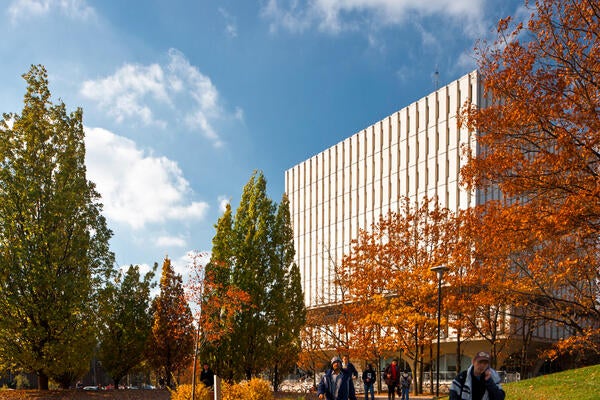
'This must be our top priority'
University of Waterloo methane researchers team up in urgent battle against climate change

University of Waterloo methane researchers team up in urgent battle against climate change
By Brian Caldwell Faculty of EngineeringThose spectacular shooting flames associated with oil and gas production aren’t doing a good enough job of protecting the environment.
Known as flares, they play an important role in the reduction of greenhouse gases fueling climate change by converting methane that would otherwise be released into the atmosphere into much less harmful carbon dioxide (CO2).
But recent studies suggest that flares in oil and gas fields are considerably less efficient than previously thought, a discrepancy that could be responsible for additional annual emissions equivalent to those produced by up to 8.8 million cars in the United States alone.

Waterloo researchers with a helicopter used for airborne hyperspectral measurements of methane. From left are Dr. Kyle Daun, Michael Nagorski, Augustine Wigle, Dr. Paule Lapeyre and Daniel Blackmore.
To help tackle that urgent problem, a research team led by Dr. Kyle Daun, an engineering professor at the University of Waterloo, is working with a sophisticated infrared camera to more accurately measure how well flares convert methane into CO2.
“We are rapidly approaching a climactic tipping point, in some ways much faster than scientists thought was possible,” he says. “We must act now. This must be our top priority.”
The $650,000 hyperspectral camera - on loan from the Department of National Defence and the only one of its kind in Canada – works by generating thousands of images, each at a different wavelength, to distinguish different gases across a scene.
Deploying the camera for methane measurement is part of FlareNet, a strategic network of the Natural Sciences and Engineering Research Council of Canada involving researchers from five universities and the National Research Council.

A hyperspectral image of a flare at a refinery shows a plume of unburned hydrocarbons that is invisible to the naked eye.
“Issues like climate change are inherently multidisciplinary and require experts from different backgrounds to work together,” says Daun, a professor of mechanical and mechatronics engineering. “In the case of FlareNet, we have experts in fluid mechanics, thermal radiation, aerosols and combustion all working together to solve a common problem.”
Better data is crucial to reaching a 2030 target to reduce 2012 methane emission levels in the Canadian oil and gas industry by 75 per cent, part of the country’s climate commitment under the Paris Accord.
Government regulators also need tools to assess whether targets are being met and climate scientists require accurate nationwide methane inventories to model the potential impacts of global warming on climate change
Daun and his team also spent part of the summer in Alberta assessing several candidate methane quantification technologies in conjunction with the Petroleum Technology Alliance Canada, Carbon Management Canada and the Clean Resources Innovation Network.
These technologies, most of them developed by Canadian companies, include infrared cameras, hyperspectral cameras and lasers.
Also involved in that project, lending their expertise in statistical analysis, are Dr. Audrey Beliveau and Dr. Christiane Lemieux of the Department of Statistics and Actuarial Science at Waterloo.
“All the technologies used to measure methane emissions produce estimates with varying levels of uncertainty,” Lemieux says. “Statistical modelling and analyses are required to correctly assess this uncertainty and understand how accurate the estimates are.”
Researchers hope to build on the project with the purchase of their own, $1-million camera, and by broadening the multidisciplinary Waterloo collaboration to include Dr. Maria Strack from the Faculty of Environment and Dr. Laura Hug of the Faculty of Science to use the technology for measuring methane emissions at wetlands and landfills.
Wetlands alone account for more methane emissions than all sources created by human activity and they are changing in ways that are difficult to predict.
Daun describes it all as an important team effort in the face of a pressing need – and an opportunity – to make a difference by reducing emissions of methane, which has an environmental impact approaching 100 times greater than CO2 over 20 years.
“Methane has a much shorter lifespan than CO2, so if we stop emitting methane now, we could see an almost immediate benefit,” he says. “I worry what kind of world we’ll leave for our children. If we don’t deal with this while we still can, it could be the failure of our generation.”

Read more
Here are the people and events behind some of this year’s most compelling Waterloo stories

Read more
Twenty-six researchers receive federal funding to drive discovery, innovation and research infrastructure development

Read more
The Royal Society of Canada welcomes five new fellows and one RSC College member from the University of Waterloo
The University of Waterloo acknowledges that much of our work takes place on the traditional territory of the Neutral, Anishinaabeg, and Haudenosaunee peoples. Our main campus is situated on the Haldimand Tract, the land granted to the Six Nations that includes six miles on each side of the Grand River. Our active work toward reconciliation takes place across our campuses through research, learning, teaching, and community building, and is co-ordinated within the Office of Indigenous Relations.